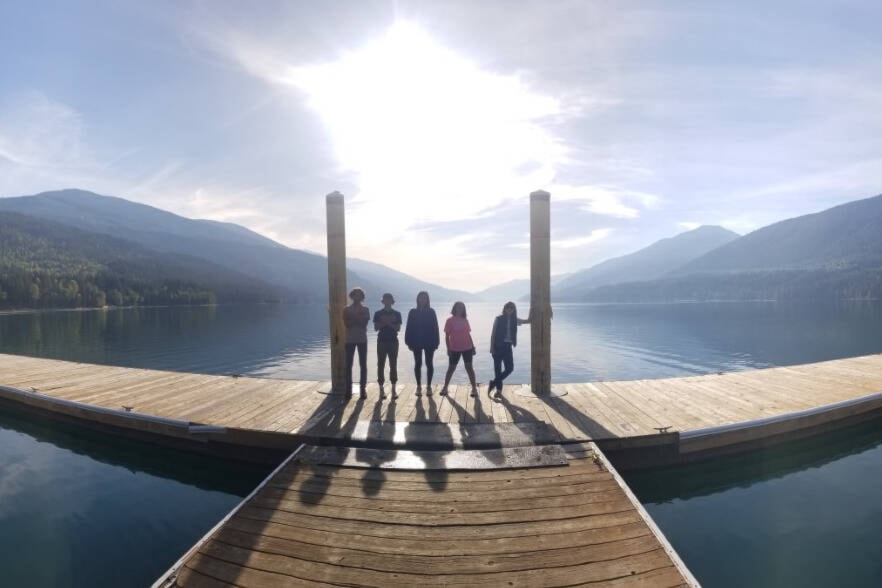“History does not belong to us; we belong to it”- Hans-Georg Gadamer
A good story engages and makes connections. It is easy to remember a tale when submerged in the plot. Making these links with historical events, culture, and facts from the classroom is the goal of the annual West Kootenay Historical Tour hosted by teacher Jonny Coleshill for students from Seven Summits Centre for Learning.
A deeper understanding and explanation are found on the road of discovery. By walking the streets, talking to locals, and gleaning hands-on experiences, students obtain a different, potentially more accurate story about history. In addition, making connections beyond the curriculum provides more authentic learning experiences.
The Seven Summits Grade 10 Social Studies class travelled from Rossland to Castlegar, Slocan Valley, New Denver, Trout Lake, Nakusp, and back. The objective was to learn about culture, history, waterways, both past and present.
“Each year on this trip, students really get a feel for what life would have been like in the Kootenays during the last 100 years,” said Coleshill. “Everything from the distance we travel, the remoteness of some of the areas, and the cool morning temperatures, help us to learn about the challenges people would have faced beyond their stories. Student presentations on location have each of them being an expert on a place. They help the stories, challenges, injustices, and incredible histories all come to life.”
“We each presented a portion of the trip from research we did before going,” says Roan Slaney-Freer. “The area I presented was the Doukhobor Discovery Center in Castlegar and the suspension bridge. The Doukhobors were farmers and settled the area as it was like their Eastern European homelands. They went through many highs and lows but still are in Castlegar today.”
Continuing up the scenic Slocan Valley, students stopped at nk̓ʕáwxtən (Vallican), an ancient Sinixt village and burial site along the Slocan River. Sinixt elder and Smum iem matriarch, Marilyn James presented on Sinixt perspectives, including how her people have always been and continue to be profoundly and spiritually connected to their ancestors and təmxʷúlaʔxʷ (land).
In New Denver, the students visited the Nikkei Internment Memorial Centre to learn the story of thousands of Canadians of Japanese descent who were interned during World War II.
“The camp was sad,” said Finlay Smith. “It was a bad time in Canadian history. Although it was uncomfortable to learn about, I feel like it was necessary.”
The students toured the Japanese Gardens outside the Centre.
“They were beautiful people and full of history; I was given a calming feeling as soon as I walked in. So wonderfully welcoming, and their message was so important,” said Allegra Sanderson.
That night the group stayed at the historic and allegedly haunted Windsor Hotel in Trout Lake. According to the Arrow Lakes Historical Society website, the hotel was born out of the once-mining boom of the 1890s. Today, Trout Lake is verging on ghost town status.
Most buildings have disappeared since the town’s original heyday, but not the Windsor Hotel.
“It just had a creepy feel to it, there was no way I could sleep,” said Oceanne Verot. “I mean, nothing moved or was like you see in a horror story, but there is some real history in that place.”
The students stopped to learn about the Canadian Pacific Railway on the way back. This information was presented by Verot, who said, “The CPR is a railway built to unite Canadians from coast to coast physically. It started in Halifax and ended in British Columbia. It was built on February 16, 1881, and only took five years to complete. The Canadian government enabled an estimated 15,000 Chinese to build the end of the railway that was in British Columbia.”
Their last stop was Sandon, one of BC’s legendary ghost towns, where they experienced the historical museum showcasing the Silver Rush of the 1800s. Students toured what remains in Sandon. Ainsley Ellis presented this site from boom to bust: the political, geological, and natural disasters that shaped this once prosperous city.
“It spoke to the human greed and romanticism that fueled the gold and silver rush of the 1890s and the disastrous loss of life,” said Ellis.
The group completed the two-day tour back to the hometown of Rossland with a greater understanding and less mystery in the Kootenay history.
“It’s great to get out of the classroom, school, and Rossland for a few days, to get to know each other that little bit more, in a structured and informal learning experience,” concluded Coleshill.
Thank you to the RDKB and Leroi Community Fund for supporting this worthwhile trip; this generosity helped demystify the mystery in history.
Contact information: For further media information, please contact Seven Summits Centre for Learning Administrator Tanis Shippy at info@sevensummitslearning.com
Author: Tara Hauck, Marketing Coordinator Seven Summits Centre for Learning.
About us: Seven Summits Centre for Learning is an exceptional public high school experience that offers a blended learning model for grades 8 through 12 in Rossland, B.C.
